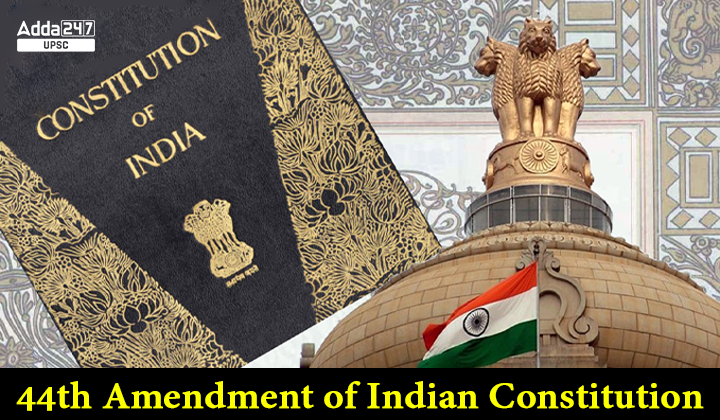Table of Contents
44th Amendment of the Indian Constitution
- Indian Constitution leaves scope for amending the Constitution in order to make sure that it stays relevant to the changing times. This is why sometimes the Indian Constitution is also called the ‘Living Document’.
- Article 268 in Part XX of the Constitution: It deals with the powers of the Indian Parliament to amend the Constitution and its procedure.
- It states that the Parliament may amend the Constitution by way of addition, variation, or repeals any provision in accordance with the procedure laid down for the purpose.
44th Constitutional Amendment Act 1978- Background
- In 1978, the Janata government decided to enact the 44th amendments act through the 45th Amendment Bill in order to reverse various questionable modifications that were brought through the 42nd Constitutional Amendment Act 1976.
- For example, the 44th amendment act modified Article 352 in order to make it more transparent and increase the accountability of the ruling government during a national emergency under the Constitution.
- There were many other amendments were made to the Constitution through the 44th Constitutional Amendment Act. They are listed below-
44th Amendment Act- Key Amendments
Regarding Parliament and State Legislatures
-
- Restoration of tenure of Lok Sabha and Rajya Sabha: 44th Amendment Act restored the original term of the Lok Sabha and the state legislative assemblies which is 5 years.
- Quorum: 44th Amendment Act restored the provisions with regard to the quorum in the Parliament and state legislatures.
- Parliamentary Privileges: 44th Amendment Act also omitted the reference to the British House of Commons in the provisions pertaining to the parliamentary privileges.
- Right to Report: 44th Amendment Act gave constitutional protection to publication in a newspaper of true reports of the proceedings of the Parliament and the state legislatures.
Regarding the President of India and the Governor of states
-
- 44th Amendment Act empowered the president to send back once the advice of the cabinet for reconsideration.
- It also made the reconsidered advice is to be binding on the president.
- 44th Amendment Act deleted the provision which made the satisfaction of the president, governor, and administrators final in issuing ordinances.
Regarding the Supreme Court and High Courts
-
- 44th Amendment Act restored some of the powers of the Supreme Court and high courts.
- 44th Amendment Act also deleted the provisions which took away the power of the court to decide the election disputes of the president, the vice-president, the prime minister, and the Speaker of the Lok Sabha.
Regarding National Emergency and President’s Rule
-
- Armed Rebellion: 44th Amendment Act replaced the term ‘internal disturbance’ with ‘armed rebellion’ in respect of national emergency.
- Role of Cabinet: 44th Amendment Act provided that the President can declare a national emergency only on the written recommendation of the cabinet.
- Procedural Safeguards: 44th Amendment Act made certain procedural safeguards with respect to a national emergency and President’s rule.
- Suspension of Fundamental Rights: 44th Amendment Act provided that the fundamental rights guaranteed by Articles 20 and 21 cannot be suspended during a national emergency.
Other Key Amendments:
-
- Made the right to property a legal right: 44th Amendment Act deleted the right to property from the list of Fundamental Rights and made it only a legal right.
44th Constitutional Amendment Acts Relevance for UPSC Exam
-
- GS Paper 2: Indian Constitution- Historical underpinnings, evolution, features, amendments, significant provisions, and basic structure.




 TSPSC Group 1 Question Paper 2024, Downl...
TSPSC Group 1 Question Paper 2024, Downl...
 TSPSC Group 1 Answer key 2024 Out, Downl...
TSPSC Group 1 Answer key 2024 Out, Downl...
 UPSC Prelims 2024 Question Paper, Downlo...
UPSC Prelims 2024 Question Paper, Downlo...





